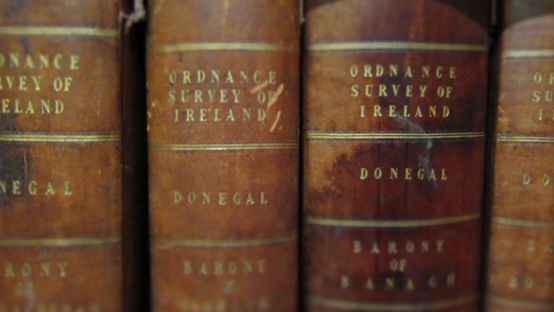 The Ordnance Survey of Ireland, conducted between 1824 and 1846, is the only survey of Ireland to have ever been conclusively finished. Under the direction of Thomas Larcom, the Master-General of the Ordnance Survey and the Board of Ordnance, a complete Map of Ireland at the scale of six-inches to one-mile was published.
The Ordnance Survey of Ireland, conducted between 1824 and 1846, is the only survey of Ireland to have ever been conclusively finished. Under the direction of Thomas Larcom, the Master-General of the Ordnance Survey and the Board of Ordnance, a complete Map of Ireland at the scale of six-inches to one-mile was published.
One of the most important functions of the Ordnance Survey was to name the geographical features, prominent buildings and landmarks of each townland so that these could be included on the Ordnance Survey Maps when they were eventually published. This task was given-over to a number of Topographical, or Names Experts. Most of these experts were bilingual Irishmen, quite a few of whom had been Irish Hedge Schoolteachers. The ‘Topographical’ information was collected in a series of books, one for each of the parishes of Ireland. These books are known as the Ordnance Survey Name Books.
Information for each townland was collected and written into the Name Book under five headings: the received name, the name finally adopted for the townland and the one placed onto the 6-inch Ordnance Survey Map in 1837. The Name Book also provided the Irish form of the name and in many instances what the Irish form of the townlands’ names meant. This was the last stage of the ‘Topographical’ process. John O’Donovan, the translator of the Annals of the Four Masters, an Irish-speaking scholar and scribe, was the Ordnance Survey’s overall Names Expert. It was O’Donovan’s responsibility to enter all the Irish versions of names into the Names Books, in addition to the English spelling recommended for the published maps. For this reason the Ordnance Survey of Ireland Names Books are sometimes referred to as O’Donovan’s Names Books.
The orthography section of the Names Books provides the various spellings for each townland or place and the authority section gives the source from which these variations were derived. This was a controversial part of the Survey, especially in the Irish-speaking areas of Ireland. Thomas Larcom, the head of the Ordnance Survey, and his names expert, John O’Donovan, had a clear policy when it came to the variant spellings and meanings of Irish place-names, which was to adopt ‘the version which came closest to the original Irish form of the name’. This showed ‘a well-intentioned deference to the Irishness of Irish place-names’. This remained the ‘Official Policy’ of the Ordnance Survey from the 1830 onwards. For the names of demesnes and houses, the only authority sought was that of the owner of the property.
The final section, entitled observations, can provide a wealth of information. Commonly this includes the main topographical features, both natural and man made, the name of the owner, the rents levied on the landlord’s tenants, the type of crops grown, type of soil. Individual observations are made on large houses, churches and geographical features of note all of which provide a valuable description of every townland in Ireland in the 1830s.
In addition to the 6-inch maps and Names Books other manuscript material associated with the conduct of the Ordnance Survey includes fair plan maps, field contents books, employment books and city maps. The original 6-inch maps can now be viewed online at www.osi.ie.
